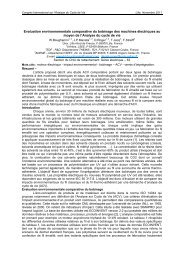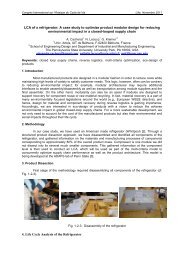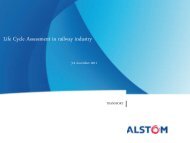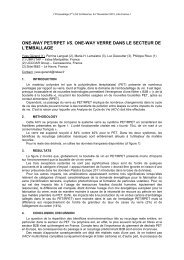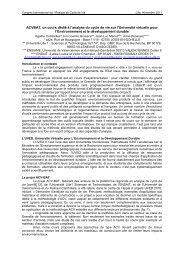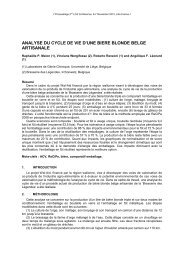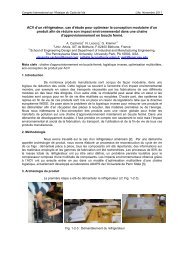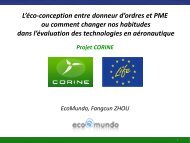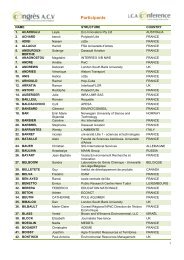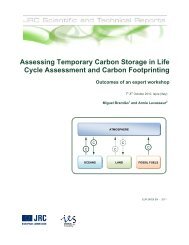Untitled - avniR
Untitled - avniR
Untitled - avniR
Create successful ePaper yourself
Turn your PDF publications into a flip-book with our unique Google optimized e-Paper software.
Congrès International sur l’Analyse du Cycle de Vie Lille, Novembre 2011<br />
Methodology for environmental comparison of dyeing processes<br />
Vanessa Pasquet, Anne Perwuelz, Nemeshwaree Behary<br />
ENSAIT, GEMTEX, F-59056 Roubaix, France<br />
Univ Lille Nord de France, F-5900 Lille, France<br />
Vanessa.pasquet@ensait.fr ; anne.perwuelz@ensait.fr ; nmassika.behary@ensait.fr<br />
Keywords: eco-design, textile dyeing, green chemistry<br />
1. Introduction<br />
Strict legislations and an increasing ecological concern have transformed eco-design in a<br />
necessity for textile industry. Meanwhile, new technologies are developed and can substitute traditional<br />
treatments [1]. However, in order to justify these alternatives, it is necessary to quantify environmental<br />
impacts of these multi-parameters systems [2]. In a view of eco-design, we develop a methodology<br />
suitable for comparison of equivalent textile processes using life cycle assessment tool.<br />
We applied this methodology to the comparison of the three most common dyeing processes of<br />
polyester, fibre which is widely used in the textile industry:<br />
Dyeing below 100°C with the help of carriers (dyeing with carriers))<br />
High-temperature and pressure conditions dyeing (HT, HP dyeing)<br />
Continuous dyeing: padding – drying – fixing (Pad-therm dyeing)<br />
2. Methodology<br />
2.1. Goal and scope of the study<br />
In order to obtain the same colour and durability properties for the three dyeing processes, we<br />
performed laboratory tests and study influence of several parameters like amount of dye, temperature,<br />
time, etc. As a result, the functional unit chosen is to “dye 1 kg polyester fabric with a colour strength given<br />
by a K/S value 5 around 16,7 and good rubbing and washing durabilities (given by a 4/5 to 5/5 cotation)”.<br />
Quantify a dyeing process is difficult as the combinations used by dyers are numerous and different for<br />
each batch. There are many other combinations that could lead to this result.<br />
Contrary to a classical life cycle assessment, we focus on a single-stage life cycle: dyeing<br />
polyester fabric.<br />
2.2 Life cycle inventory<br />
Data of inventory for textile processes are often aggregated, missing, unclear, uncorresponding to<br />
the fonctional unit choosen or cannot be extrapolated to industrial scale in the case of data obtained from<br />
laboratory. In this study, we assigned the same degree of precision of data inventory for each process.<br />
2.3. Results<br />
The life cycle assessments are realized thanks to the software GaBi 4. The CML 2001 method<br />
(updated in November 09) is used to calculate the environmental impacts.<br />
Water consumption<br />
150<br />
Global Warming<br />
Potential<br />
Eutrophication<br />
Potential<br />
100<br />
50<br />
0<br />
Energetic ressources<br />
Abiotic Depletion<br />
Acidification Potential<br />
Dyeing with carriers Pad-therm dyeing HT, HP dyeing<br />
5 K/S corresponds to a value characterising the colour strength of a sample depending on its spectral reflectance at a<br />
given wavelength<br />
- 89 -



